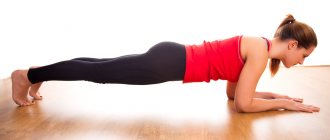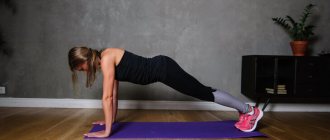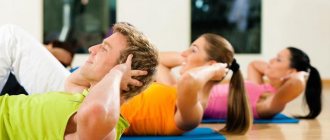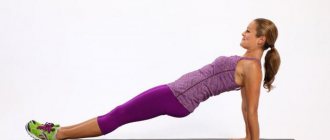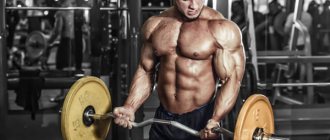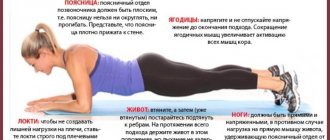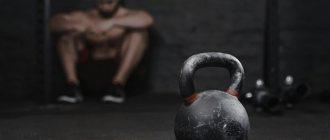The side plank works well Surface Electromyographic Analysis of Core Trunk and Hip Muscles During Selected Rehabilitation Exercises in the Side‑Bridge to Neutral Spine Position of the rectus and oblique abdominal muscles, and at the same time - unlike many abdominal exercises - does not put a compressive load on the lower back . Moreover, the side plank strengthens Serial Case Reporting Yoga for Idiopathic and Degenerative Scoliosis back muscles and, when performed regularly on one side, helps correct scoliosis.
The Lifehacker Telegram channel contains only the best texts about technology, relationships, sports, cinema and much more. Subscribe!
Our Pinterest contains only the best texts about relationships, sports, cinema, health and much more. Subscribe!
You can do the plank every day. Don't be afraid of monotony: there are many variations of this exercise, so you won't get bored.
Atlas of working muscles
According to the law, the more muscle groups work when performing an exercise, the more difficult it is, and the better its loading capacity. A proper side plank engages the following muscles:
- rectus and oblique abdominal muscles (while the waist does not increase in circumference);
- stabilizers (muscle groups responsible for balance and fixing parts of the body relative to each other), small-medium-large gluteal, lumbar, iliocostal, all pectoral groups, levator scapula, etc.;
- the latissimus and trapezius dorsi muscles are indirectly involved.
The many muscles involved in training indicate the extreme benefits of exercise for improving the athlete’s physical fitness.
Benefits of this exercise
When performing effective training, you should be aware of the following benefits:
- Elasticity and firmness of the buttocks (which is very important for girls). You will not only give the butt the desired shape, but also easily get rid of the unpleasant “orange peel” of cellulite.
- Strengthening the back muscles. This activity is considered an excellent prevention of osteochondrosis of the cervical and lumbar region; in addition, you can get rid of lobes and aches in the shoulders and interscapular area. Most often, pain occurs due to systematic sitting at a desk or carrying heavy bags.
- Slender legs. After the first days of training, you will already be able to admire the first results, due to the involvement of all leg muscles.
- Flat tummy. Due to systematic tension of both the lateral abdominal muscles and the lower abs.
- Hands are pulled up. Your upper limbs will become pumped up, as they take on the load of half of the entire body weight.
- Development of general flexibility. Muscle tissue and ligaments are stretched.
- A powerful encircling muscle corset is created that wraps around the waist.
- Improved posture and coordination. Balancing on the elbow or palm develops the ability to hold the body in weight.
- Reducing back pain.
- You can exercise at home, without the cost or purchase of additional equipment.
Existing contraindications
The side plank exercise in some cases can bring not only benefits to the athlete, but also harm. Note that there are not many contraindications, but it is necessary to know about them. The training is not recommended in the following cases:
- if you have been diagnosed with an intervertebral hernia;
- if injuries to the neck, shoulders or back are detected;
- if the woman is in the last months of pregnancy;
- if strong, sharp pain of any nature systematically occurs.
Exercise technique
The effect of the execution is also increased due to the fact that the emphasis falls on a pair of support points instead of the standard four. You will have to try hard not to lose your balance.
- Lie on your left side, and place your elbow directly under your shoulder.
- Straighten your legs as straight as possible.
- Place your right hand on your right thigh and continue to keep your legs straight.
- Raise your pelvis off the floor, tensing your abdominal muscles, until your body forms a diagonal to the floor. Balance on your feet and forearms.
- Stay in this saved position for 35-45 seconds. If it doesn’t work right away, it doesn’t matter, try again so that you can achieve 30 seconds in the total amount of approaches. Change the side of the support and repeat everything from the beginning again. Start with a few seconds, gradually increasing the load.
Like on the beach
It will be more convenient to balance in sportswear and sneakers on a special mat. Starting position - lie on your side, the elbow of one hand is strictly under the shoulder, the second hand on the hip, legs straight. Don't lower your head, look straight.
In the photo, the side plank resembles a popular beach pose for a memorable photo. All that remains is to raise the pelvis so that the body is stretched into a string. After a short break, duplicate using the other arm and leg.
Side plank complications
To diversify the load and complicate the exercise, you can try the following variations of its implementation.
- With your leg raised. Lift your top leg up. Thus, the area of your body support is reduced, and the load on the abs is significantly increased.
- With a raised hand. Raise your hand up. In this case, you will have to apply additional force to avoid falling on your side.
- On fitball. Place your feet on a gymnastic ball, this will increase the tension on your muscles.
- With rolls. Lying on your right side, straighten your legs, lean on your forearm and elbow to lift your body. Roll into a classic plank position, continuing to keep your body in a straight line. Stay in this position for 20 seconds. Then roll onto the left side of the side plank support. The main thing is to make sure that the body forms an even straight line.
- Improved. Starting position: lying on your side, legs bent at approximately 90 degrees and lying on the floor. Leaning on your elbow, lift your pelvis, maintaining balance on your bent knees. All muscles should be in maximum tension.
Newbie mistakes
Most often, those who do not perform the side plank correctly cannot stay in the pose. Let's look at the most common mistakes made by novice athletes, which also happen to professionals:
- Bent, hunched back. In this position, it is difficult to maintain balance, your back quickly begins to hurt and it is difficult to breathe.
- Incorrect hand position. If the hand is placed at a different angle than necessary, there will be a risk of injury to the joints of the hand, the inability to perform the exercise, and improper load on the body.
- Sagging of the pelvis during fixation. If the buttocks are not tense, the movement will not be possible, since these muscles are the main ones for performing the plank.
- Head down. A chin lowered toward the chest makes breathing difficult and creates unnecessary stress on the neck muscles.
- Relaxed or bent knees. Due to this position of the legs, proper execution of the exercise will be impossible.
Read also: Standing arm extension on a block
Secrets of proper execution
To achieve maximum results for your abs and all other muscle groups, you need to follow the tips below.
- Before you freeze in the plank, statically tense your abs and buttocks.
- Keep your neck in accordance with the position of your spine, do not tilt or twist it.
- The spine area and, in general, the middle part of the back should under no circumstances sag or touch the floor. The body from head to heels should turn into a straight line.
- The elbow of the hand on which the support rests should be exactly under the shoulder joint.
- It is better to place a large mirror near you to control the correct execution.
- If you are overweight, you should refrain from performing the side plank; at a minimum, consultation with a doctor is required.
- For each side, do 3 approaches. The optimal holding time in the top position is 45 seconds.
Useful tips
Let's share a few more tips on how to learn how to do a side plank.
- There is no need to be afraid. It is impossible to injure yourself if there are no contraindications to the plank.
- To perform the plank, you do not need to visit a gym or fitness center. It can be done at home, on the sports ground, even at work, if there is space.
- When performing the exercise, every 3-4 days you need to increase the time of balancing on your side by 5 seconds.
- There is no time of day restriction for the side plank. If you have time and desire, it can be done several times a day.
After doing the side plank every day for more than 21 days in a row, this exercise becomes a healthy habit that can help anyone quickly become lean and healthy.
Side plank for back pain
Colombian surgeons conducted an independent study. His subject was the effect of the side plank exercise on scoliosis. Subjects who performed this activity for six months experienced a decrease in back pain by an average of 35 percent.
Teenagers showed the best results - their figures reached 49 percent. Thus, if you suffer from a disease such as scoliosis, then using the side plank you can not only reduce pain in your back, but also correct your posture.
Variations
Like all exercises, the side plank has its own types: some make it more difficult to perform, others make it easier.
The following variations are possible:
- on the knees;
- from an elevated position;
- with hull failure;
- with body rotation;
- with raising and holding your leg up.
Side plank on knees
Starting position: you need to kneel with your feet hip-width apart. Place one hand on your belt. Bend toward your other hand and place it on the floor, extending the opposite leg parallel to the floor. The body weight is completely transferred to the knee of the supporting leg.
We stand in this position for the maximum (for your level) amount of time. If you are a beginner, then 20 seconds for the first time is more than enough.
To simplify this option, you can raise and lower your free leg. At the same time, do not forget to tense your hips and buttocks.
Elevated side plank
This option is suitable for beginners, as it is easy to perform.
The higher your upper body is, the easier the exercise. The side plank from an elevation is most often done with the elbow resting on a chair, sofa, low cabinet or any other low but stable surface. Thanks to this, it is easier for the muscles of the supporting arm and abdomen to support the weight of the entire body.
I recommend starting with this option if the classic one is still difficult to implement. But don’t get carried away, move on to more complex types of planks, since in this case, without progression of loads, you may not get results.
Side bar with body dip
This is a dynamic version of the exercise.
Starting position is the same as in a regular side plank. Movement of the pelvis down and up is added. Perform the exercise slowly, maintaining proper technique.
Side plank with rotation (body rotation)
Also a dynamic version of the side plank, but more difficult to implement than the previous one. When performing it, the body spends much more kcal, so it fits perfectly into a fat-burning training program. For the press, such a variation is just fire, judging by the reviews of the trainees.
The starting position is the same as in the classic version. We raise our free hand up, then bend it, between the body and the floor. In this case, the body must be turned slightly following the hand. Then return to the starting position and repeat the movement for as long as you can maintain proper technique.
Do everything smoothly, feel how the muscles tense from the load.
Side plank with leg raised and held at the top
I almost never see this kind of plank in the gym, but complicating the classic version of the side plank by raising and holding your leg up is what the coach prescribed.
The peculiarity of this exercise is that the support is only on two points: on the arm and leg of the same name (that is, only on the right or left). This is quite difficult, so it is suitable at least for “continuers”.
The advanced side plank technique begins with the correct starting position. We stand like a classic side plank, and then raise the free arm and leg of the same name up.
Since it is static, you will need to keep your body in this position as long as you can.
It is important to keep your body tense and not dangling in the air. This is the only way you will load the target muscles that stabilize the core.
Are side planks effective for losing weight on your sides?
The most painful issue for girls is exercises to slim down their waist. To achieve the desired volumes, you need to work with lateral exercises: lateral extension on the machine, standing dumbbell crunches, and so on. As photos of athletes show, these exercises not only locally remove the sides, but also significantly increase the oblique muscles. With regular training and increasing weight, the waist can “grow out”. When performing a side plank, the muscles contract isometrically, their strength gradually develops and the so-called “corset tightening” appears. If your goal is to remove your sides, then reduce active dynamic exercises to a minimum, and pay close attention to the side plank.
An effective exercise will allow you to work the maximum number of muscles at once. If you add exercises for the buttocks and chest, the training complex will methodically adjust your figure to the ideal parameters.
